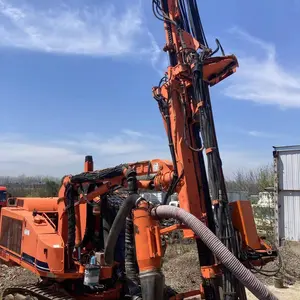

Cheap 15.6ton Component Optional Used Tamrock Ranger Dx800 Top Hammer Rock Drilling Rig Drilling Rig On Sale


Water Well Drilling Rig 200 Meters Deep Well Drilling Machine Trailer Mounted Water Well Drilling Rig Oilfield Drilling Rig










The realm of drilling technology has been revolutionized by the advent of portable borehole drilling machines, a versatile category of drilling equipment designed for various geological tasks. These machines cater to a range of applications, from water well drilling to mineral exploration, offering a compact and mobile solution for industries that require drilling capabilities on-the-go.
There are several types of portable drilling rigs available, each with unique mobility features. Some are equipped with caterpillar treads, enabling them to navigate challenging terrains with inclines of up to 25 degrees. Others feature rubber tires for easier transport on conventional roads, and some models may require external transportation means. The choice of mobility options ensures that these machines can be deployed in diverse environments, from remote areas to more accessible sites.
The technical prowess of portable water well drilling rigs is evident in their varied drilling depths and capabilities. Certain models boast the ability to drill over 200 meters deep, suitable for extensive geological explorations and coal mining operations. Conversely, more compact units are designed for shallower depths, such as open-pit mining up to 3 meters, making them ideal for smaller-scale projects. The direction of drilling is also versatile, with equipment capable of vertical, horizontal, and angled drilling to suit specific project requirements.
A comprehensive drilling equipment setup typically includes an air compressor, mud pump, various sizes of drilling rods, connectors, and a robust drilling tower. The drilling process is facilitated by an array of drill bits, such as diamond bits, alloy ring-shaped bits, 3-wing alloy bits, PDC bits, and hammer bits. These are employed in different drilling methods like rotary, percussion, blast hole, and core drilling, each chosen based on the geological conditions and desired outcomes.
The features of portable drilling machines are tailored to their operational demands. Smaller units, with a lifting capacity of around 25 kilonewtons and a weight of approximately 2,500 kg, are perfectly suited for tasks in confined spaces, such as domestic farms or residential areas. Larger models offer increased power and speed, making them a go-to choice for commercial and industrial drilling operations. The versatility of these machines lies in their adaptability to various drilling conditions and their ease of transport, ensuring efficiency and practicality in the field.
Selecting the appropriate portable borehole drilling equipment hinges on understanding the scope of work and the specific requirements of the drilling project. With a broad spectrum of machines available, it is crucial to consider factors such as drilling depth, surface hardness, hole diameter, and the physical demands of the job site. By assessing these parameters, one can identify the most suitable portable drilling solution to meet the needs of any drilling challenge.